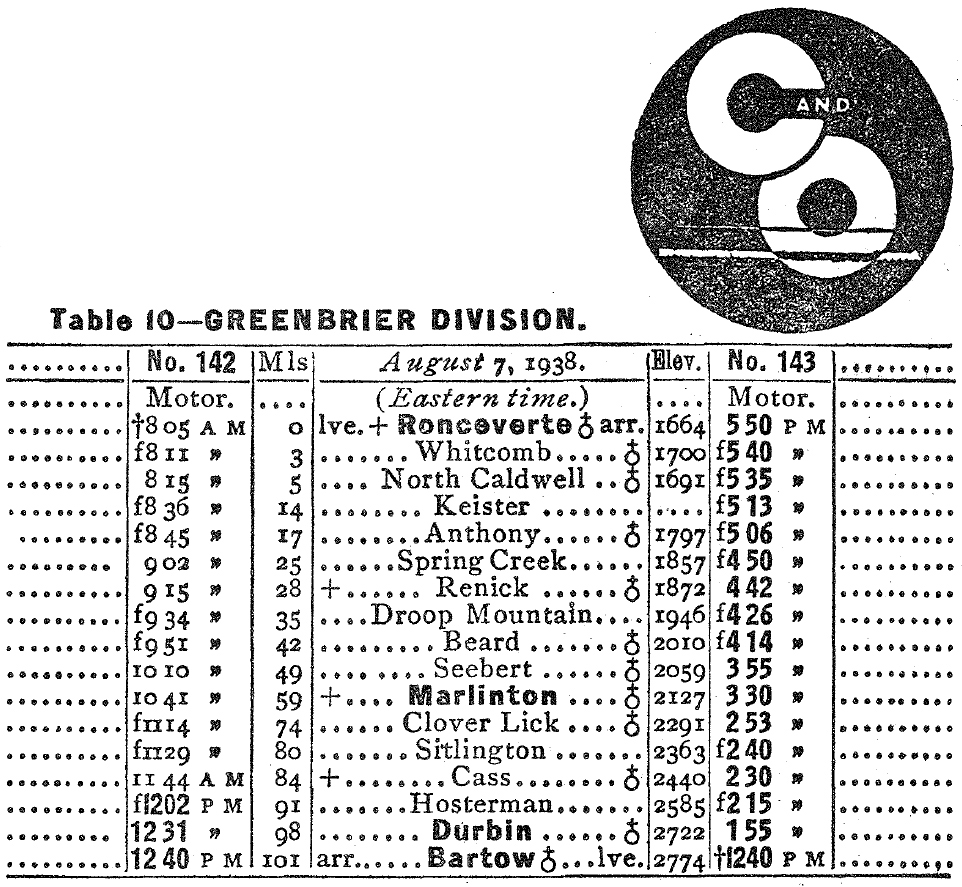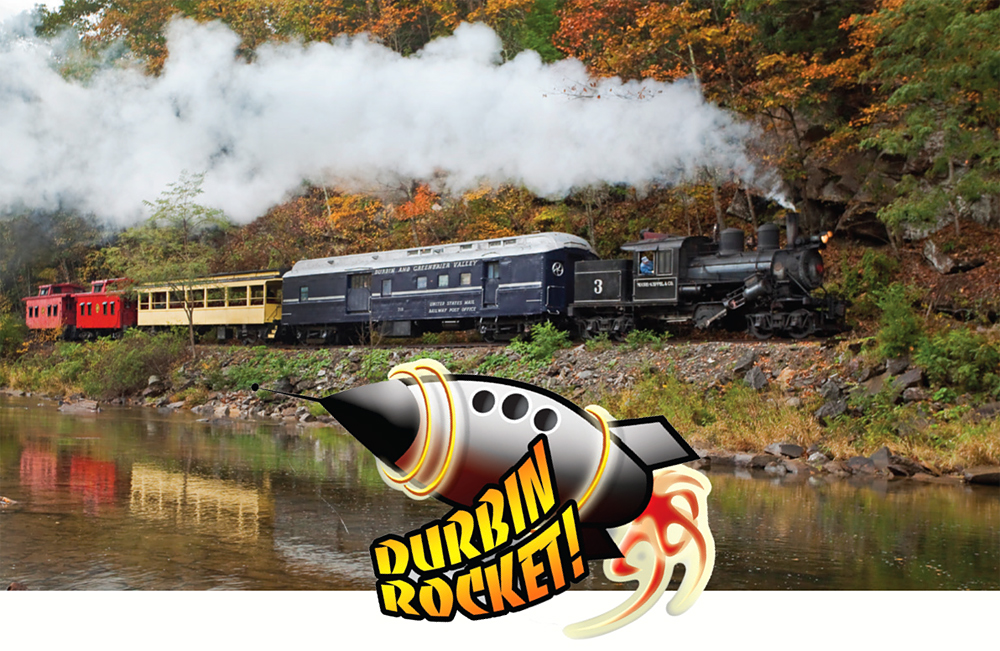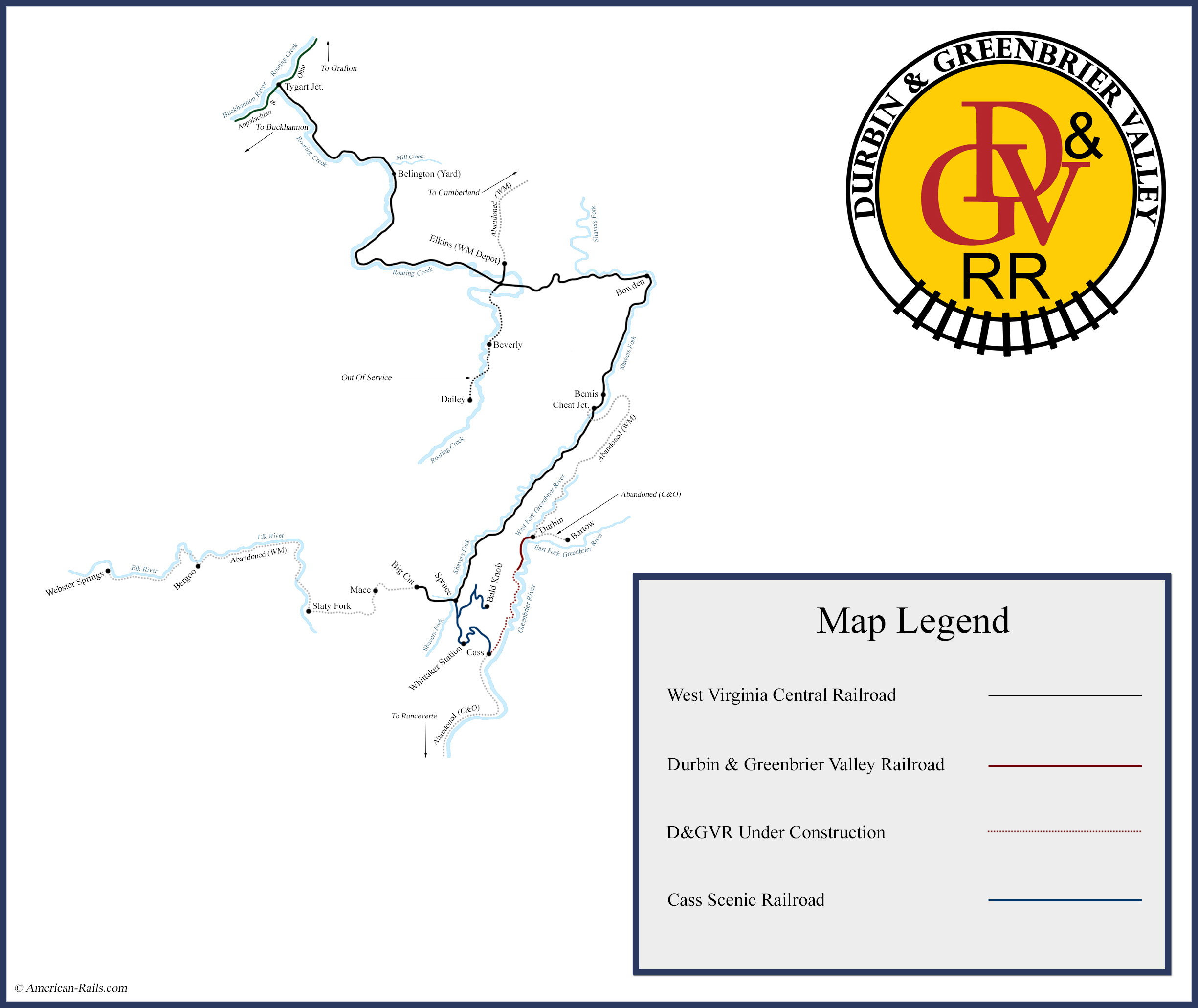Durbin & Greenbrier Valley Railroad
Last revised: October 11, 2023
By: Adam Burns
The Durbin & Greenbrier Valley (reporting mark, DGVR) is a tourist railroad based in Durbin, West Virginia. It operates slightly over 5 miles of Chesapeake & Ohio's former Greenbrier Division.
Better known as the Durbin Rocket, the train acquired its moniker during the 1990's when the engineer would humorously tell passengers "this train's gonna take off like a rocket," in reference to its slow speeds.
The route south of Cass is currently a popular, state-owned recreational corridor known as the Greenbrier River Trail.
The first component of John and Kathy Smith's rail operations that now spans multiple states and railroads was launched in 1997.
Despite its rural location the D&GV has gained a loyal following; owners John and Katy Smith now also operate the nearby West Virginia Central (which includes 132.4 miles of former Western Maryland trackage north, south, and east of Elkins) and a Virginia short line.
For those interested in rail history, the Durbin & Greenbrier Valley features an operating geared steamed locomotive.
Most importantly, the D&GV will soon rejoin the national rail network as crews are working to rebuild the washed out right-of-way to Cass. The future looks bright for this tourist railroad!
A Brief History Of The Durbin & Greenbrier Valley Railroad
In reality, the Durbin & Greenbrier Valley Railroad (D&GV) is only one component of a growing operation originally launched by the Smiths in 1997 when the D&GV initiated excursions over 2.2. miles of the Chesapeake & Ohio's former Greenbrier Division, or "Greenbrier Branch."
The 14-mile Cass-Durbin segment was originally acquired by the state of West Virginia in 1977 and operated excursions from that time until devastating flooding on November 4-5, 1985 severely damaged the right-of-way.
The current active portion includes the former wye at Durbin (where the Western Maryland's old Durbin Branch to Elkins made a connection) and heads south along the Greenbrier River.
Following its startup, D&GV volunteers diligently worked to rebuild another 3, a process accomplished by 1998 (the same year in which the West Virginia Central was launched).
About a decade later, in 2006, the Smiths won a contract to operate the Shenandoah Valley Railroad, a Virginia-based short line maintaining 20.2 miles between Staunton and Pleasant Valley, Virginia.
This railroad interchanges with CSX and Buckingham Branch Railroad in Staunton, and Norfolk Southern in Pleasant Valley.
Chesapeake & Ohio's "Greenbrier Branch"
The Greenbrier River Trail is one of West Virginia’s premier recreation corridors, spanning nearly 80 miles along its namesake river in the eastern Appalachian Mountains.
The pathway traces its history back to the Chesapeake & Ohio Railway, which constructed the railroad grade during the late 1890s to serve timber, tanneries, and other businesses then booming in the region while interchanging with a handful of notable logging railroads (such as the property now operated as Cass Scenic Railroad).
After World War II freight traffic began declining considerably, particularly as lumber operations closed.
As a result the Greenbrier Branch was eventually considered superfluous and the C&O/Chessie System elected to abandon most of the corridor, nearly 100 miles in length, during the late 1970s.
Similar to the nearby Baltimore & Ohio, Norfolk & Western, and later Virginian Railway the C&O derived a large portion of its freight revenue from the movement of Appalachian coal, predominantly located in the Mountain State.
However, black diamonds was not the only resource West Virginia provided; logging, forest products, and other business lay in the Greenbrier Valley which C&O officials hoped to exploit.
To reach this area a long branch was required, running northward along the Greenbrier River.
On November 16, 1897 a charter was issued for the Greenbrier Railway Company, extending from a connection with the main line near Ronceverte at Whitcomb to a northward point along the river.
In 1905 the line, by then a wholly-owned property of the C&O since 1903, reached the small hamlet of Winterburn marking its longest length at 100.96 miles according to William McNeel’s book, “The Durbin Route.”
This location was slightly northeast of Durbin, the primary northern interchange point with the Western Maryland Railway, which had reached that small town via Elkins through a subsidiary known as the Coal & Iron Railway chartered on December 14, 1899 and completed on July 27, 1903 roughly 47 miles in length.
Once it was realized rail service would open in the valley new lumber operations such as Greenbrier River Lumber Company (near Marlinton) and West Virginia Pulp & Paper Company (near what is present-day Cass) began acquiring several thousand acres of timber tracts in the area.
The WVP&P is noteworthy as having received an order from the Wright Cycle Company of Dayton, Ohio, owned by Wilbur and Orville Wright, who purchased 500 feet of spruce lumber to construct “flying machines.” The brothers, of course, went on to invent the world’s first-known airplane.
As early as September of 1900 freight service had commenced and was soon far exceeding the railroad’s expectations.
Within the first decade of the 20th century the Greenbrier Division (also known as the Greenbrier Branch or Greenbrier Subdivision) was serving more than 40 sawmills of various size (from the Cass complex capable of producing 60,000 board-feet per day to independently-owned operations producing only a few-thousand feet daily).
Another important source of traffic was tanneries located at Frank and Marlinton, the former owned by the Pocahontas Tanning Company and latter owned by the U.S. Leathery Company; both were in operation by 1905.

Additionally, various other types of freight traveled the line including agriculture and livestock thanks to the many farms in the valley as well as aggregates/stone shipped from the quarry at Renick owned by the Renick Stone Company.
Finally, due to the rural nature of the region and lack of reliable highways, for many years virtually anything needed was shipped by rail ranging from furniture and farming supplies to food and coal for home heating.
During its busiest years in the 1920s the Greenbrier Branch hosted four passenger trains and several local/manifest freights each day.
The peak year for freight tonnage, outside of World War II, occurred in 1926 when 1,750,300 tons were handled, much of this derived from the mill at Cass.
Following the Great Depression, improved highways, and exhaustion of timber tracts business slowly declined although did experience a spike during World War II where 1943 saw 2,136,400 tons of freight handled.
This level quickly subsided after the conflict and continued declining until the route was eventually abandoned. The final scheduled passenger trains (#142 and #143) made their runs on January 8, 1958 while the Western Maryland’s own connections at Durbin were dropped during April of 1959.
By then regular steam-powered service had already left the valley, replaced by diesel locomotives, after late December of 1955.
However, they occasionally returned, usually to handle excursions and fan trips, behind notable locomotives such as Reading Class T-1 4-8-4 #2102 or geared designs which from nearby shuttered logging operations, including at Cass where the Cass Scenic Railroad was launched in 1963 after remaining rail operations ceased there in the early summer of 1960.
By the early 1970s the once busy Greenbrier Branch witnessed freight reduced to only a few hundred carloads annually as most lumber and tanning operations had closed.
On March 18, 1975 the Chessie System/C&O filed an application with the Interstate Commerce Commission to abandon 92.04 miles of the Greenbrier Branch from near North Caldwell to Durbin, leaving the remaining few miles for the Western Maryland to continue service north of that point to then-Bartow, 2.84 miles.
The last train made its run on December 27-28, 1978. The trackage was then removed during July of 1979 and the entire right-of-way donated to the state of West Virginia.
The Mountain State has long been a staunch rail proponent, dating back to the 1960's when it preserved the former Mower Lumber Company's operations at Cass.
In 1978 it became the first state to own and operate a freight railroad when it purchased Baltimore & Ohio's 52.4-mile Petersburg Branch (Green Spring - Romney - Petersburg), operated by new short line startup South Branch Valley Railroad.
When the 1985 floods ended excursions north of Cass, operations around Durbin remained dormant for more than a decade.
In his article, "Mountain Railroad Empire: The Durbin & Greenbrier Valley Railroad," featured in the May, 2007 issue of Trains Magazine, author Alan Byer notes that John Smith had been interested in West Virginia railroads since he visited Cass as a boy at the age of 12.
Originally from Pennsylvania, he moved to West Virginia in 1988 and watched with keen interest the Mountain State's changing, and sadly, declining, railroad landscape during the next 10 years.
CSX Transportation was particularly aggressive in abandoning or selling large components of former Western Maryland and Baltimore & Ohio lines in northern West Virginia.
In the 1990's it petitioned the Interstate Commerce Commission to shed its remaining WM trackage. John, and wife Kathy, both attended those abandonment hearings.
While these lines were ultimately saved by the State Rail Authority, the agency announced the rails between Durbin and Cass would be removed and the right-of-way converted to a trail.
However, the Smiths successfully convinced the state to allow a new tourist attraction to take over the property.
As a result a license for the Durbin & Greenbrier Valley Railroad was issued in July, 1996 although it came with a major stipulation; the state would provide no subsidies, requiring the couple to go it alone.
They began by purchasing a small, 20-ton, gas mechanical diesel switcher originally built by the Whitcomb Locomotive Works for the U.S. Navy in 1939.
To carry passengers a flatcar was acquired from an Army base in North Carolina. Elsewhere, a caboose was leased. Interestingly, D&GV's first task was to support the nearby South Branch Valley Railroad, which needed the switcher to help repair flood damage.
Using the money from this work, plus the sale of their trucking business, the Smiths debuted the 4.4-mile (round-trip) Durbin & Greenbrier Valley in July, 1997 with trains departing from the preserved C&O depot. By the spring of 1998 the group had rebuilt 3 more miles.
Durbin & Greenbrier Valley Locomotive Roster
|
Railroad/Number Middle Fork RR (Moore-Keppel) #3 Meadow River Lumber Co. #6 Middle Fork RR #7 |
Arrangement 2-Truck Climax (55-ton)* 3-Truck Heisler (90-ton) 3-Truck Heisler (80-ton)*** |
Builder/Date Climax/1910 Heisler/1929 Heisler/1939 |
Location Durbin, WV Durbin, WV** Durbin, WV |
* Overhaul. Out-of-service.
** Operational. From Cass Scenic Railroad.
*** Restoration.
The Durbin & Greenbrier Valley slowly grew in popularity as evermore visitors came to ride this rural West Virginia curiosity.
The railroad's publicity dramatically increased when it acquired former Middle Fork Railroad 2-truck Climax #3 from the Connecticut Trolley Museum in 2001.
It was placed into service during the spring of 2002. Today, along with the D&GV's Durbin Rocket, the WVC operates climate-controlled excursions along parts of the old Western Maryland near Elkins (complete with locomotives painted in WM livery).
These trains include the New Tygart Flyer, Cheat Salamander, and Mountain Explorer Dinner Train among others.
Today, The Durbin Rocket hosts trips from May through October. Within the next few years the D&GV will finally reconnect to Cass as work wraps ups on rebuilding the entire 14-mile segment.
It was initially part of a long range plan, unveiled in 2012 during a presentation to the West Virginia State Tourism Commission, to also rebuild the former Durbin Branch (now today's West Fork Rail Trail).
Doing would have allowed for a significant boost in tourism whereby guests could ride aboard the West Virginia Central, Durbin & Greenbrier Valley and Cass Scenic Railroad as part of a 90-mile loop from Elkins to Cass, and return (via Spruce).
Unfortunately, the expense to do so proved too great even with a plan to utilize former trackage of WM's long-abandoned branch to Bergoo/Webster Springs.
The problem was the costs associated with repairing Tunnel #2 at Glady, located just east of Cheat Junction. The cost to do so could not be justified according to Mr. Smith.
Nevertheless the Cass-Durbin section (15 miles) was completely restored by February 1, 2023 according to the railroad.
You may also purchase reserved seating in advance although to do so you will need to either visit their website or call ahead. And on that note, please click here to visit their website and learn more about all of they have to offer (tickets can also be picked up directly in the depot).
SteamLocomotive.com
Wes Barris's SteamLocomotive.com is simply the best web resource on the study of steam locomotives.
It is difficult to truly articulate just how much material can be found at this website.
It is quite staggering and a must visit!


